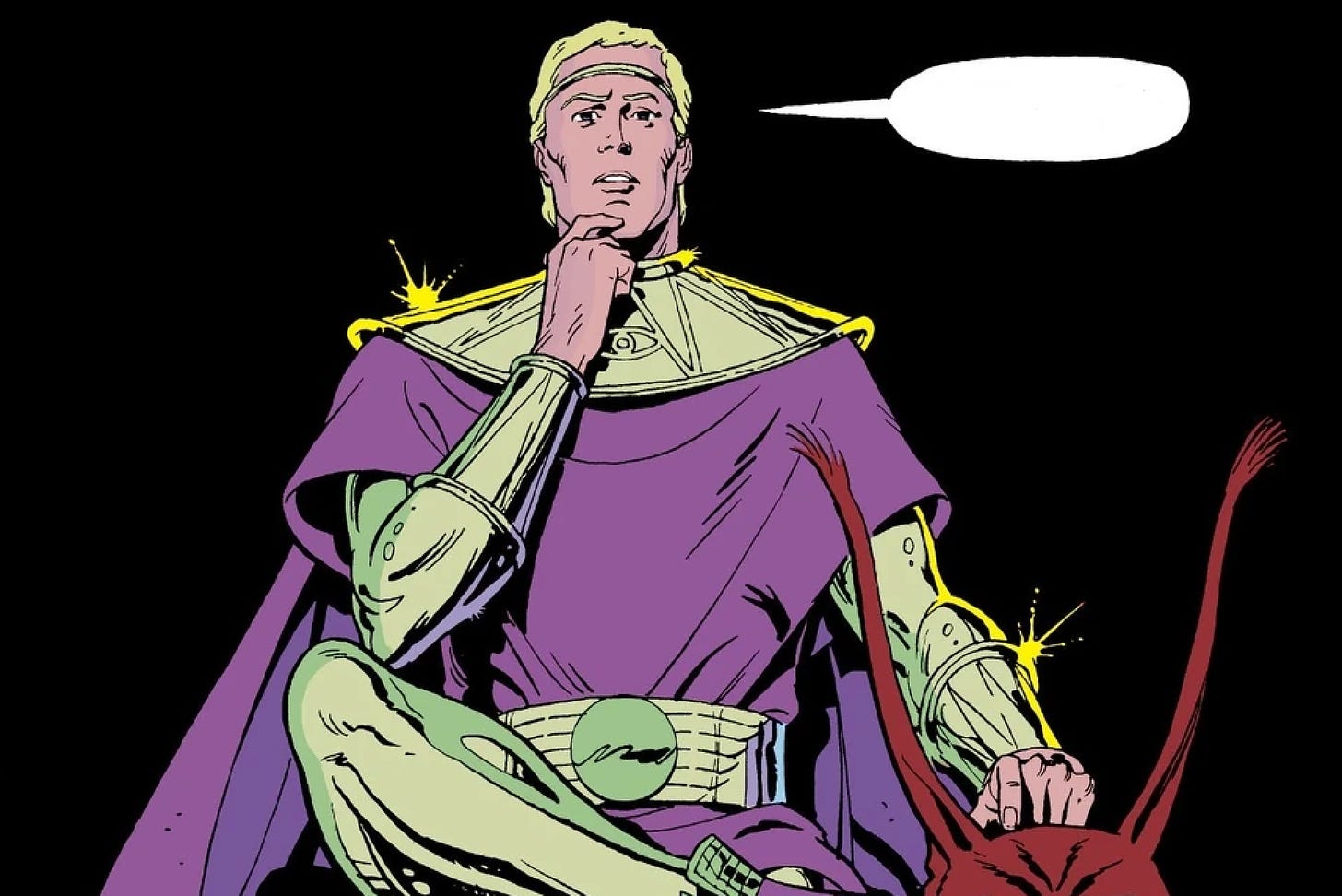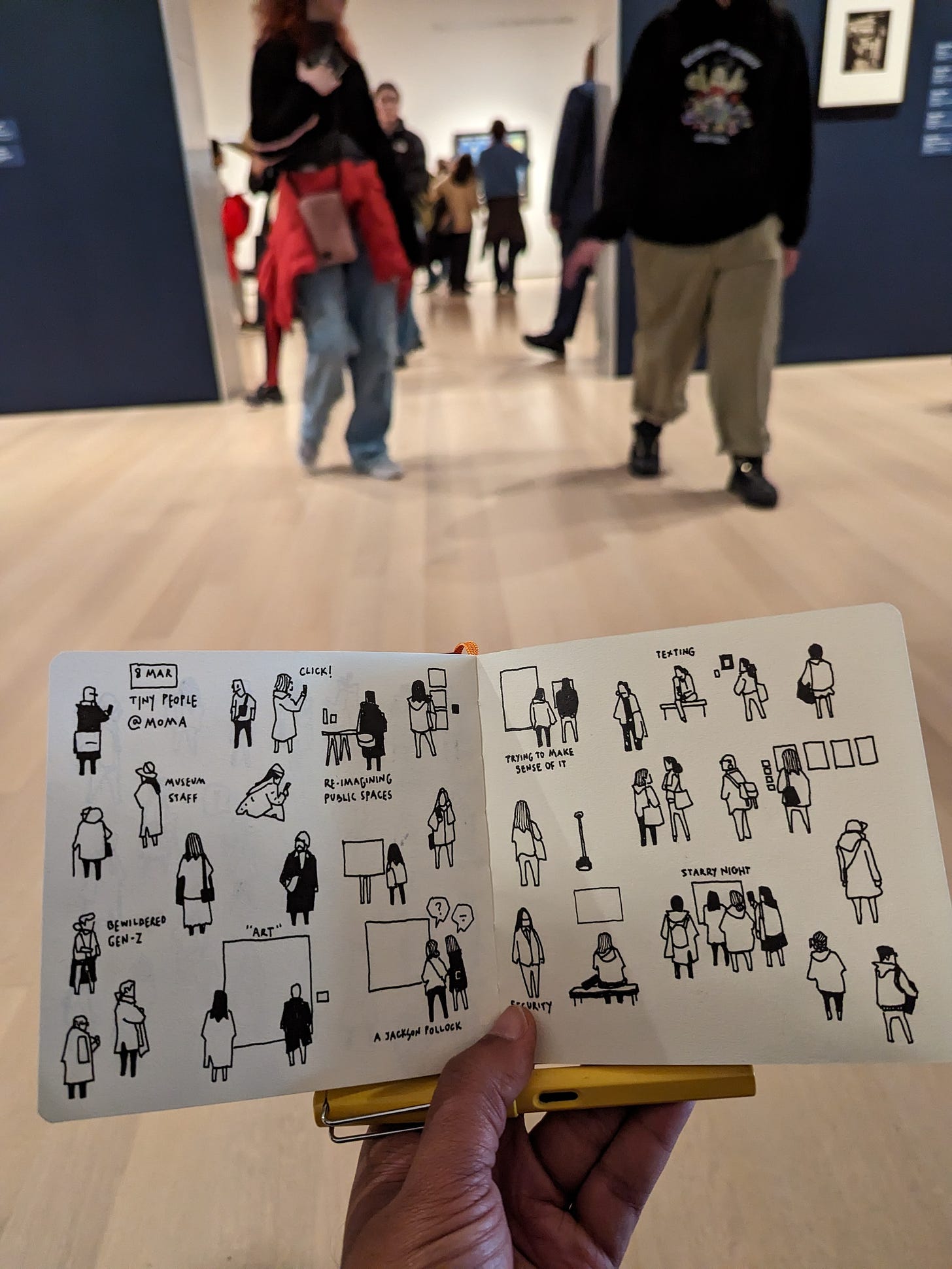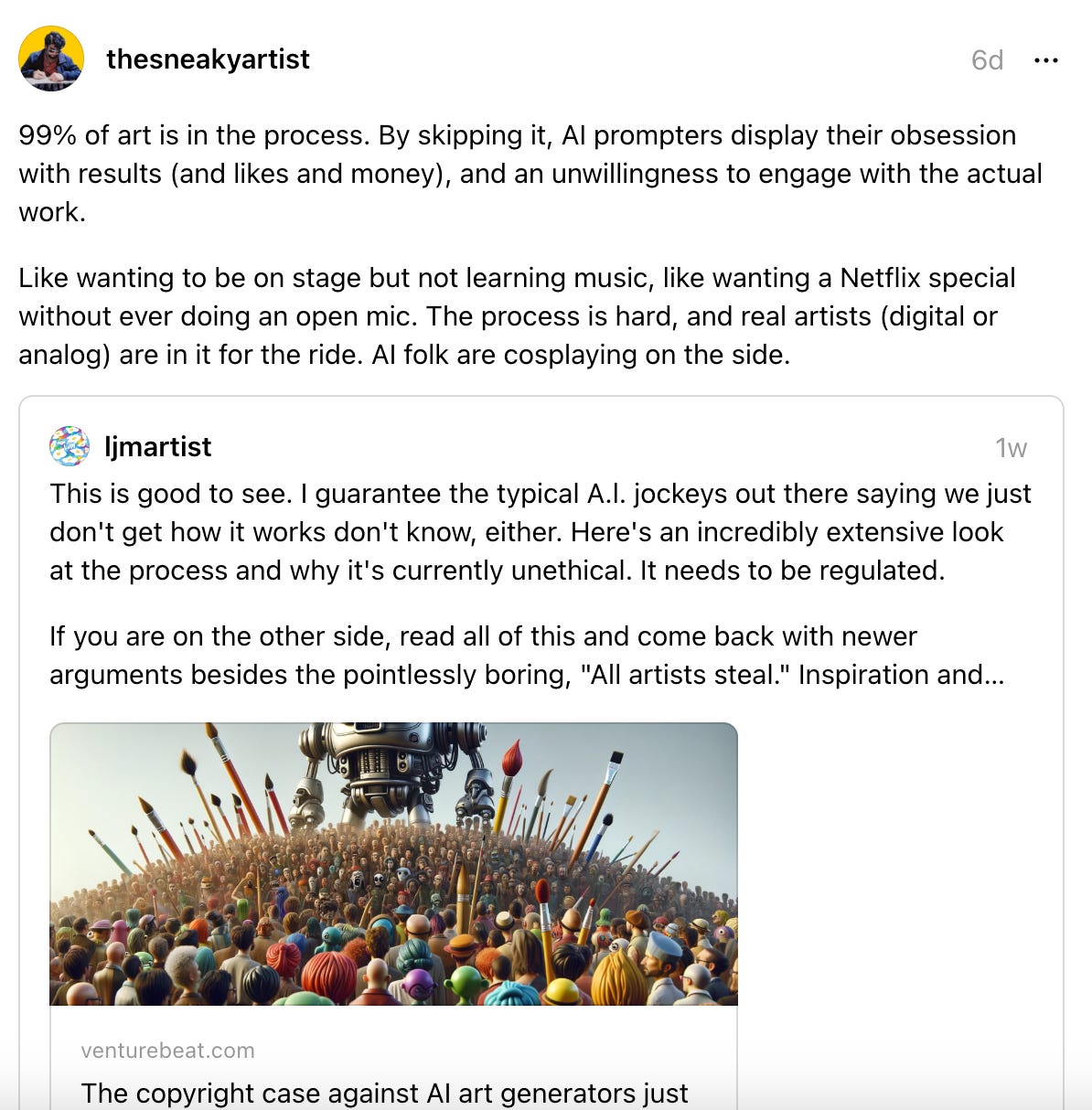Art and Artificial Intelligence
Insider #116 with human thoughts about artificial intelligence
Dear Insider,
This post is going out to all readers of this publication as part of my resolution to learn in public. If you enjoyed reading it, buy me a coffee!
***
This year, against my will, I have confronted the spectre of AI looming over everything. AI is going to replace artists. It is going to replace lawyers. It is going to replace coders. And middle managers. Some people are going to become very, very rich. Others will be free to do whatever else they wish. AI is the cashier wishing you a good day. AI is your therapist listening on the other end. AI will be your teacher. AI will be your lover. With a micro-transaction, you could train it to be both at the same time. Are you ready? It doesn’t matter. AI is going to replace writers and their readers. At the end of the world, a trillionaire will look at the desolate remains of human existence and ask if it was worth it. An AI will respond, sure why not.
The SneakyArt (Insider) Post is written for patrons and supporters of SneakyArt. Every Sunday this month, I am conducting a year-end audit to look back at the highs and lows of this year.

In many ways, it has been a remarkable year. And in many ways, I set out to make it so.
The first post of this year was a declaration of resolutions that would guide me through 2023. And with this audit, I am examining the success and failure of these ideas. Last week, I shared the best moments from this year on the SneakyArt Podcast. Before that, I shared my resolution to make this a Year of Zero Commentary.
In today’s Insider Post, I share some thoughts on AI as Artist. To be in the loop with my best writing, grab the special winter deal to subscribe.
Not all Artificial Intelligence is machines. A lot of it is human.
***
God is a popular title for the things beyond our control - all the mysterious forces of our world before whom we are rendered powerless. Over centuries, by gaining mastery over our physical environment, the scope for Classical Godliness has been reduced. Demand has plummeted.
But whenever old gods die, new gods are born. An insatiable need for godlike figures is a core property of being human.
Essential reading: American Gods by Neil Gaiman.
***
Many people desperately need you to believe in the superhumanity of AI because hype makes money faster than reality.
Essential reading:
on the supply paradox of AI.***
Many people desperately need you to believe in the superhumanity of AI because they dislike being human.
***
A lot of people making high six-figure salaries in tech are not well educated at all. They are only vocationally trained.

***
Pareidolia is the human tendency to see human shapes in non-human things. Like seeing a face on the rocks of a cliff. Like seeing shapes in the stars. But of course there is no face. But of course there is no shape. It is a false-pattern recognition device that has nevertheless helped us navigate the seas and achieve great things.
My professor of control engineering shared this quote once during a lecture - “All models are wrong. But some models are useful.”
***
“Anyone unable to understand how useful religion can be founded on lies will not understand this book either.” - Cat’s Cradle, Kurt Vonnegut.
***
Here is a definition of colonialism:
To extract the value from a stolen thing without caring for how it was made or by whom, even at the cost of its destruction. To not care about what you destroy, because it was never yours, as long as you can squeeze every drop of its worth.
To call the destruction a tragedy, and the profits an inevitable necessity.
We are in the middle of a period of cultural colonization. It is being presented as an inevitability.
Read The Anarchy by William Dalrymple.
***
***
In The Work of Art in the Age of Mechanical Reproduction (1936), Walter Benjamin expressed concerns about how art would be transformed by infinite reproducibility in the form of prints, films, and recorded music. How would art maintain its value if anyone was free to engage with it however they wished? Could art retain its authenticity when seen out of context?
He wondered what would be lost in the convenience of this reproducibility. His word for these interconnected ideas was aura.
***
I thought about it at the MoMA, drawing people as they confronted the aura of Starry Night. Aura is like a mirror. You can look into this mirror to see many things, but everything you see just reflects you.
It is a very human thing to believe in aura. Aura is itself a very human thing.
***
The shattering of aura by mechanical reproduction had profound consequences. Nearly one hundred years later, the essay reads like a time capsule. At the cusp of a new era of reproducibility, there is much to learn from these old ideas:
“The destruction of the aura is the mark of a perception whose sense of the sameness of things has grown to the point where even the singular, the unique, is divested of its uniqueness—by means of its reproduction.” - Walter Benjamin.
The shattering of aura broke art into infinite fractals, each completely unique but just like the others. We have a word for it now. That word is ‘content’.
Watch The Shock of the New (1980), a multi-part documentary about the last 100 years of art.
***
AI systems are not like human brains.
Human minds do not consume all the information out of everything before taking action. One of the most remarkable things about the human brain is that it operates on very little information - incomplete and biased data, rough ideas, memory holes, confabulations, hints, and clues buried deep within our psyche.
***
The Reverse Turing Test is this - Can you interact with a human and be fooled into believing it is a machine?
This is possible not only because of how good the machines have become. Human life has become more machine-like too.
We are closing the gap from both ends of the problem.
Our tendency to see humanity in machines is affected by the diminished scope for human expression outside of machine interfaces.
***
Would the patrons of Renaissance Florence appreciate Dali’s surrealism? Would Andy Warhol’s Brillo boxes be a hit in ancient Rome?
Creativity is socially embedded.
Kandinsky sought to create an Art that was free from the encroachment of the camera. Art is always in conversation with its culture. This conversation is always rooted in its Time. We are part of this conversation because of our human understanding of human affairs.
AI makes art only in its ability to imitate human creativity.
Essential reading: The Lonely City by Olivia Laing
***
Making art is the most intensely human thing you can do.
The real crime of the AI Art movement is not anything it does, but what it stops you from doing. By eliminating you from the process of creation, it reduces your humanity. There is deep self-loathing at the heart of being an “AI-artist”.
***
Art is all process. The artist’s life is all journey, no destination.
***
Anything that can be produced at zero cost by anyone anywhere in the world is – by definition – mid.
***
The artist is present.
Bold Predictions
In two years, AI Art will be as inimitable and useful as stock photos. It will also be just as valuable as a stock photo.
The value of verifiably human things will skyrocket.
This is the best time to be an artist.
Also, this note by
:In the coming weeks, I will share -
🗓️ month-by-month highlights of this year, my most successful as an artist and writer,
💌 the idea of building systems instead of setting goals,
📲 the experience of becoming a huge Instagram account, and all the lessons from six years of being an artist on social media.
All this and more is part of my year-end audit with SneakyArt Insiders, the patrons and supporters of my work. To get it in your inbox, simply become a SneakyArt Insider.
Thank you, dear reader, for your time and attention. I am glad to have a space in your inbox. If you enjoyed reading this post, buy me a coffee!











Great post. The AI true believers are developing “technology” that is not useful for the things that matter. I do not want self-driving cars, AI-generated essays or AI-generated art. I certainly don’t want the true believers stealing content from my emails and texts and comments and photo albums, or stealing it from my children and my friends. I don’t want more gadgets to make me more efficient, that really are designed to make me do more work. I am not a number or sequence of 0’s and 1’s. I am a human being, who wants to focus on the being.
I applaud your efforts at taking inventory of your goals, and willingly share the results with us all. Great example of being accountable to yourself. And great articles you’re sharing.